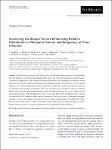Examining Landscape Factors Influencing Relative Distribution of Mosquito Genera and Frequency of Virus Infection
Junglen, Sandra
Kurth, Andreas
Kuehl, H.
Quan, Phenix-Lan
Ellerbrok, Heinz
Pauli, Georg
Nitsche, Andreas
Nunn, Charles L.
Rich, S. M.
Briese, Thomas
Leendertz, Fabian
Mosquito-borne infections cause some of the most debilitating human diseases, including yellow fever and malaria, yet we lack an understanding of how disease risk scales with human-driven habitat changes. We present an approach to study variation in mosquito distribution and concomitant viral infections on the landscape level. In a pilot study we analyzed mosquito distribution along a 10-km transect of a West African rainforest area, which included primary forest, secondary forest, plantations, and human settlements. Variation was observed in the abundance of Anopheles, Aedes, Culex, and Uranotaenia mosquitoes between the different habitat types. Screening of trapped mosquitoes from the different habitats led to the isolation of five uncharacterized viruses of the families Bunyaviridae, Coronaviridae, Flaviviridae, and Rhabdoviridae, as well as an unclassified virus. Polymerase chain reaction screening for these five viruses in individual mosquitoes indicated a trend toward infection with specific viruses in specific mosquito genera that differed by habitat. Based on these initial analyses, we believe that further work is indicated to investigate the impact of anthropogenic landscape changes on mosquito distribution and accompanying arbovirus infection.
No license information

